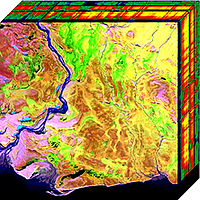
Photo from wikipedia
Barrett esophagus (BE) is a precursor to a life-threatening esophageal adenocarcinoma (EAC). Surveillance endoscopy with random biopsies is recommended for early intervention against EAC, but its adherence in the clinical… Click to show full abstract
Barrett esophagus (BE) is a precursor to a life-threatening esophageal adenocarcinoma (EAC). Surveillance endoscopy with random biopsies is recommended for early intervention against EAC, but its adherence in the clinical setting is poor. Dysplastic lesions with flat architecture and patchy distribution in BE are hardly detected by high-resolution endoscopy, and the surveillance protocol entails issues of time and labor and suboptimal interobserver agreement for diagnosing dysplasia. Therefore, the development of advanced imaging technologies is necessary for Barrett’s surveillance. Recently, non-endoscopic or endoscopic technologies, such as cytosponge, endocytoscopy, confocal laser endomicroscopy, autofluorescence imaging, and optical coherence tomography/volumetric laser endomicroscopy, were developed, but most of them are not clinically available due to the limited view field, expense of the equipment, and significant time for the learning curve. Another strategy is focused on the development of molecular biomarkers, which are also not ready to use. However, a combination of advanced imaging techniques together with specific biomarkers is expected to identify morphological abnormalities and biological disorders at an early stage in the surveillance. Here, we review recent developments in advanced imaging and molecular imaging for Barrett’s neoplasia. Further developments in multiple biomarker panels specific for Barrett’s HGD/EAC include wide-field imaging systems for targeting ‘red flags’, a high-resolution imaging system for optical biopsy, and a computer-aided diagnosis system with artificial intelligence, all of which enable a real-time and accurate diagnosis of dysplastic BE in Barrett’s surveillance and provide information for precision medicine.
Journal Title: Diagnostics
Year Published: 2022
Link to full text (if available)
Share on Social Media: Sign Up to like & get
recommendations!